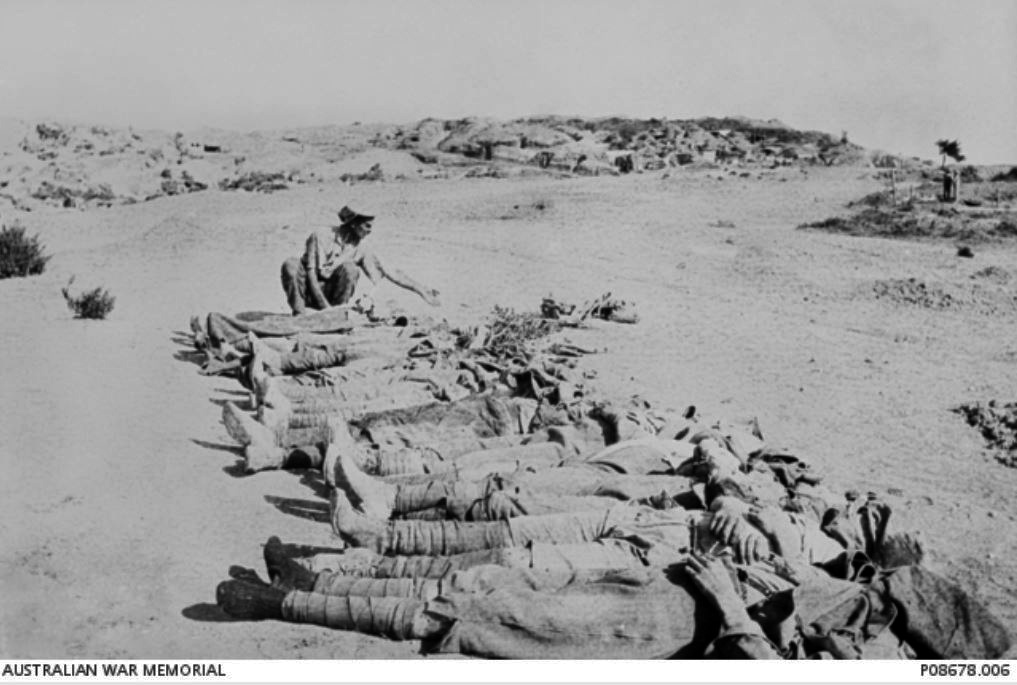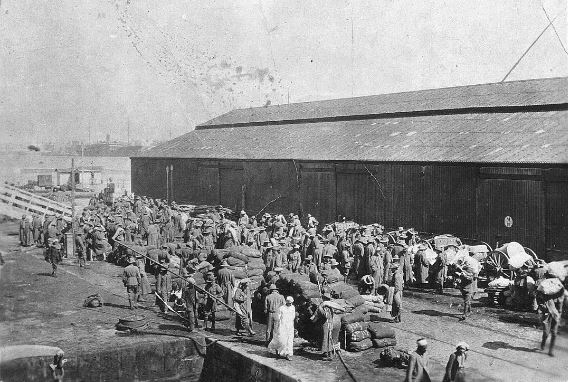11th Battalion
From Our Contribution
 Ome of the 36 11th Bn men killed at Leane's Trench. AWM photoP08678.006 | |
 11th Battalion at Alexandria enroute to Lemnos. Credit Army Museum of Western Australia | |
Contents
Brief History
The 11th Battalion was raised shortly after the outbreak of World War I as part of the Australian Imperial Force (AIF), an all-volunteer force raised for overseas service. It was the first battalion recruited in Western Australia, and following a brief training period in Perth, the battalion sailed to Egypt where it undertook four months of intensive training.
Along with the 9th, 10th, and 12th Battalions it formed the 3rd Brigade, 1st Division. Volunteers included men who had previously served in the part-time forces before the war.
The 3rd Brigade was the covering force for the ANZAC landing on 25 April 1915 and so the 11th Battalion was, along with other covering force units, first ashore at around 4:30 am. In August 1915 the battalion was in action in the Battle of Lone Pine.
Following the withdrawal from Gallipoli, the battalion returned to Egypt where the AIF was undergoing radical change. This saw the veteran battalions split to provide cadres for new battalions and as a part of this process, the 11th Battalion provided personnel to the 51st Battalion, by transferring the even numbered sections to the new battalion.
In March 1916, the battalion boarded HMT Empress of Britain, for deployment to the Western Front in France and Belgium where it took part in trench warfare until the end of the war in November 1918.
Its first major action in France was at Pozieres in the Somme valley in July 1916. After Pozieres, the battalion manned trenches near Ypres in Flanders before returning to the Somme valley for winter.
In 1917 the battalion took part in the brief advance that followed the German Army's retreat to the Hindenburg Line including defending the German counterattack at Louverval, France, in April 1917. The battalion subsequently returned to Belgium to participate in the offensive that became known as the Third Battle of Ypres.
The battalion helped to stop the German spring offensive in March and April 1918, and later that year participated in the great Allied offensive launched east of Amiens on 8 August 1918. This advance by British and empire troops was the greatest success in a single day on the Western Front, one that German General Erich Ludendorff described as "the black day of the German Army in this war".
The 11th Battalion continued operations until late September 1918. In November 1918 members of the AIF began to return to Australia. In February 1919, the 11th and 12th Battalions were amalgamated due to steadily declining numbers in both battalions. They remained so linked until their last members returned home for demobilisation and discharge.
By the end of the war, a total of over 9,000 men had served in the 11th Battalion, of which 1,115 were killed and 2,424 wounded.[1] The battalion was disbanded in 1919.
Battalion Personnel
A
- John Alexander Adamson 28 Feb 1915 - 13 Mar 1918 WIA
- David Andrew Allison a reinforcement who didn't join the battalion in the field.
B
- Edward Bailey 24 Feb 1917 - 23 Apr 1919
- Ernest Ball DCM 4 Jul 1915 - 15 Aug 1918 WIA (gassed)
- James Barber 9 Mar - 24 Jul 1916 - WIA Pozières
- Percival (Peter) Clement Bassett 2 Mar 1916 - 29 Jan 1919
- Richard Beattie 26 Dec 1916 - 11 Jan 1917 - Medical evacuation & over age
- Thomas Kinsman Bickell 17 Jan - 7 May 1917 - WIA Noreuil
- † Walter Bell Blair 6 Oct 1914 - 2 May 1915 - KIA Gallipoli
- † Richard John James Bransby 17 Jan - 6 May 1917 - KIA 2nd Bullecourt
- Leonard Henry (Lennie) Buckingham MM 9 Aug 1916 - 7 Apr 1917 - WIA
- Lancel Butcher 10 May 1917 - 20 May 1919
- William Edward Butcher MM RMG MID 12 Dec 1915 - 29 Feb 1916 - 51st Battalion
C
- William Carroll 25 - 30 May 1916 - WIA - medical discharge
- Cecil Walter Challis 17 Jan 1917 - 24 Apr 1919
- Donald Victor Chisholm 17 Mar 1916 - 15 Apr 1917 - POW Lagnicourt
- † Sidney Charles Clarke 4 Aug 1915 - 12 Mar 1916 - to 3rd Machine Gun Battalion
- Henry Thomas Cockram 7 Jan - 1 Mar 1916 - to 51st Battalion
- John Harold Coffen Aug 1914 - 28 Feb 1918 - medical
- George Sidney Cook 4 Aug 1915 - 29 Feb 1916 - to 51st Battalion
- † Herbert William Coxhead medically discharged before he joined them
- † William Moore Crellin 29 Jul 1916 - 7 May 1917 - KIA Noreuil
- Thomas Hughie Culbertson 4 - 18 Aug 1917 - to 1st Division Signals Company & 15 Mar - 24 Apr 1919
- Alfred Cecil Clarence Curtis Aug 1914 - 8 Jun 1915 - Medical
D
- † Walter Edward Dalziell 7 Jan - 29 Feb 1916 - to 51st Battalion
- Charles Henry Davis 7 Jan - 1 Mar 1916 - 51st Battalion
- Aubrey Cecil Dawson 2 Mar - 22 Jul 1916 - WIA Pozières
- Charles Henry Dohnt 28 May 1917 - 23 Apr 1919
- Alexander Donald 17 Mar - 2 Apr 1916 - to 51st Battalion
- † Frank William Dowell 2 Mar - 30 May 1916 - KIA Condonnerie, France
- Victor Emanuel Durling 7 Jan - 29 Feb 1916 - to 51st Battalion
- † Francis Dyson 7 Sep 1916 - 15 Apr 1017 - KIA Lagnicourt
E
- † Rudolf Eberhardt 2 Mar - 30 May 1916 - KIA Cordonnerie Farm, Fromelles
- Albert John Egan MID 7 Jan - 29 Feb 1916 - to 51st Battalion
- † Albert Ernest Elkington 10 May 1917 - 23 Aug 1918 - KIA Chuignes, France
- Claude Eustace Herbert Evans 24 Apr 1917 - 20 Apr 1919
- Richard Evans MM 7 Jan - 1 Mar 1916 - to 51st Battalion
F
- Walter Raymond Farnham ?? Oct 1915 - 26 Apr 1916 - Medical return to Australia
- Cyril Foxwell 15 Jun 1915 - 30 Aug 1915 - Medical return to Australia
G
- Walter Gaymer 7 Jul 1917 - 23 Apr 1919
- † Charles Maul Glover 1 Mar 1915 - 1 Mar 1916 - to 51st Battalion
- John Goffin 26 Dec 1916 - ?? Apr 1919
H
- John Hall 1 May 1917 - 14 Oct 1918
- George Joseph Harris 16 Oct 1917 - 13 Feb 1918
- William Joseph Hayden 2 Mar - 22 Jul 1916- WIA Shell shock Pozières
- Robert Sang Herd 29 Jul 1916 - 3 Apr 1919
- Thomas Hetherington 16 Jun 1915 - 31 Aug 1918
- † Frederick James Howard 17 Mar - 23 Jul 1916 - KIA Pozieres
- John Charles Hutchinson 1 Sep 1914 - 25 Apr 1915
J
- † Fritz Robert Jaentsch 7 May 1915 - 28 Feb 1916
K
- James Kershaw 7 Jan - 1 Mar 1916 - to 51st Battalion
- Arthur George Kettley 4 Aug 1915 - 30 May 1916 - KIA Fleurbaix
- Patrick Kiely 10 May 1917 - 2 Oct 1918
- Frederick William Vernon King 29 Jul 1916 - 4 Jan 1917 - died of illness
L
- † Herbert George Lewis 2 Mar - 2 Apr 1916 - 51st Battalion
- Robert Lightbody 7 Sep 1916 - 15 Mar 1918 - WIA Neuve Eglise
- William Isaac Little 29 Jun 1916 - 23 Apr 1919
- John Macarthur Livingston 10 Feb - 14 Apr 1917
M
- Melbourne Hubert Randolph Matthews 2 Mar 1916 - 16 Apr 1917 - POW
- George Badham Milton 29 Jul 1916 - 16 Apr 1917 - KIA Lagnicour
- Frank Moore 25 May 1916 - 3 Nov 1917 - WIA Zonnebeke
- † Frederick William Wallace Moore 12 Dec 1915 - 30 May 1916 - KIA Cordonnerie Farm, Fromelles
- Frederick Edwin Murphy 17 Aug 1914 - 20 Apr 1916 - to 15th Machine Gun Company
N
- Alfred Tennyson Needham 6 Dec 1917 - 3 Jun 1918 - WIA Villers - Bretonneux
O
- Herbert Frank O'Neill 17 Aug 1914 - 21 Sep 1917 - KIA Glencorse Wood
- Thomas Alfred Osborne
P
- Charles Henry Partridge
- John Laidlaw Paterson
- John Donaldson Patterson
- Arthur Pilgrim
- † Keith George Harman Podger 2 Mar - 19 Apr 1916
- Hector Louis Polain
R
- Maurice Clarence Robinson
- Stephen Henry Robson
- Robert Rueben Rodgers
- William George Rosekelly
- William Edgar Rowe
S
- David Alexander Sayer
- Henry Giles Schmidt 7 Jan - 1 Mar 1916 to 51st Battalion
- George Scrivener
- John (Senior) Shepherd
- Hugh Henry Smith 16 Jun 1915 - 24 Apr 1916 - to 48th Battalion
- John Alexander Spilsbury
- Arthur William Symonds
T
- James Thomson MM 7 Jan - 23 Jul 1916 (WIA Pozieres) - to 51st Battalion
- Frederick William Thornton
- John James Thorpe 24 May - 24 Jul 1916 (WIA - Pozieres)
- Leslie Huon Truman
- John Wesley Gladstone Turner
U
V
W
- Daniel Malcolm Wann
- Peter Grant Watt
- Frederick Robert Weedon
- Richard John Williams
- James Winning
- Vernon Claude Witney 10 May - 12 Dec 1915
Battle Honours
- ANZAC
- Landing at Anzac
- Defence of Anzac
- Suvla
- Sari Bair
- Gallipoli
- Egypt 1915-16
- Somme 1916-18
- Poziéres
- Bullecourt
- Ypres 1917
- Menin Road
- Polygon Wood
- Broodseinde
- Poelcapple
- Passchendaele
- Lys
- Hazebrouck
- Amiens
- Albert 1918
- Hindenberg Line
- Epehy
- France and Flanders 1916-18.
Individual Honours
- 1 Victoria Cross (Lt Charles Pope)
- 1 Companion of the Order of the Bath
- 2 Companions of the Order of St Michael and St George
- 7 Distinguished Service Orders
- 1 Officer of the Order of the British Empire
- 30 Military Crosses and one Bar
- 25 Distinguished Conduct Medals with one Bar
- 96 Military Medals with two Bars - (Leonard Henry (Lennie) Buckingham MM)
- 3 Meritorious Service Medals
- 85 Mentions in Despatches and
- 7 foreign awards
Notes
Content for the history and honours sections has come from a combination of Wikipedia and the Australian War Memorial websites.
- ↑ "Legs-Eleven": Being the Story of the 11th Battalion (A.I.F.) in the Great War of 1914–1918. Belford 1992 P. 665